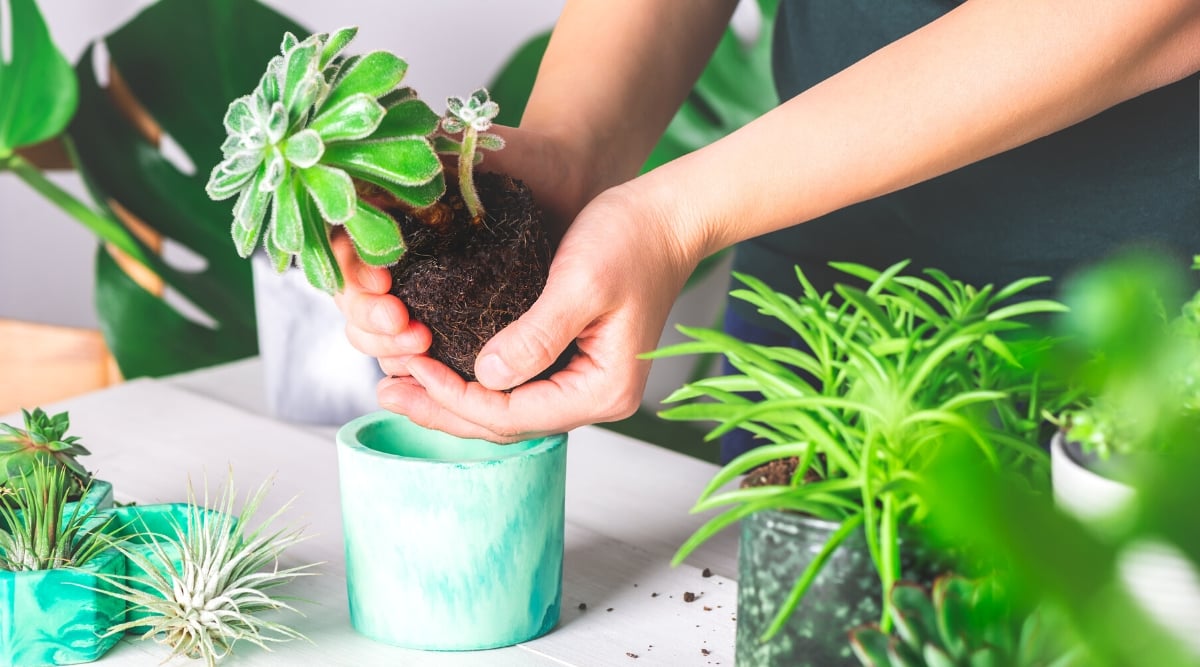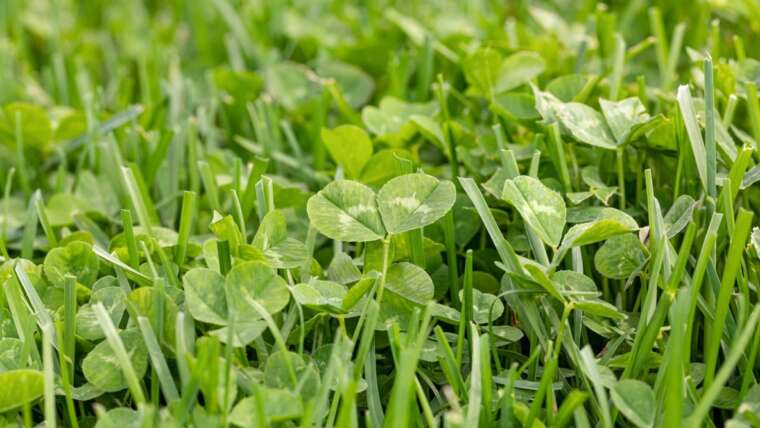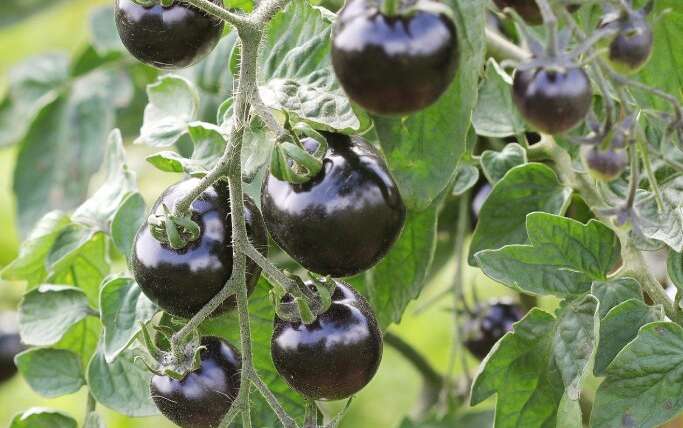Succulents are wonderful, low-maintenance plants that I find to be a joy to propagate and share with my plant-loving friends. Because of their uncomplicated needs, succulents make wonderful beginner plants. They’re ideal for any plant lover who doesn’t have much time to tend to high-maintenance plants.
The most common and successful way to propagate succulents is by the process of division. While it is possible to propagate from seeds, it takes much longer to achieve mature plants. Many succulents don’t have a great germination rate, so propagating this way can be frustrating and time-consuming.
Division will result in strong plants that should only take about one year before they are ready to bloom themselves. There are different methods of division, so it is up to the gardener to decide which one works best for them. Dividing succulents can be as complicated or simple as you choose.
The first and more complex method I’m going to go over is likely to produce the strongest divisions but can cause a lot of stress to the parent plant. If you have a good number of offsets, this is the way to ensure that most of them thrive. The alternative method is less stressful for your parent plant, but it may not produce as many successful divisions.
Let’s dig in and discuss the best ways to divide your succulents so that you can increase your own garden or pass some of your beautiful plants along to friends and family.
Maintain a Healthy Plant
Encourage succulent offsets by proper care, avoiding over-stressing, and understanding specific plant needs.
Succulent plants are slow-growing. As a result, they can’t be divided as often as some faster-growing plants. Most succulents produce offsets, creating an easy way to propagate as long as you wait for the right time.
In the meantime, you can encourage your plant to produce offsets, or pups, as they are commonly called. Healthy, well-cared-for plants can usually be divided annually.
A healthy succulent is one that has good color. Many succulents let you know they’re stressed by turning a different color, most often red or purple. Some plant owners induce this slight stress because the color shift is desirable.
A stressed succulent may be beautiful, but it’s less likely to produce offsets you can divide. If the plant is struggling to maintain its functions, it is unlikely to reproduce.
Identify your succulent and do a little research on that plant’s specific needs. Most prefer exposure conditions between bright, indirect light to partial sun. Some thrive best in full sun. Temperature is important, as well. Some succulent plants love the heat, while others prefer more temperate weather. Some need very little water, while others need to be watered regularly.
If you notice that your plant is exhibiting signs of being overstressed, it’s important to alleviate some of that stress. This will free up your plant to redirect energy from surviving to reproducing.
Determine Whether the Plant is Strong Enough to Divide
 Divide succulents when offsets resemble mature plants.
Divide succulents when offsets resemble mature plants.
Before getting started, it is important to determine whether or not the plant is ready to be divided. Put simply, a plant that has offsets is one that can be divided. While many of these plants can be propagated by leaf cuttings, it takes much longer to get a mature plant this way.
With division, you have a small copy of the parent plant that has already developed roots. The offsets are ready to divide when they look like a miniature version of the mature plant.
Don’t worry that you are harming your plant by removing the offsets. It’s quite the opposite. The pups are a drain on it. Removing them will actually free up the plant to use nutrients and water without having to support the pups.
Remove the Plant From Its Container
 Carefully remove the succulent from its container, avoiding stress and damage, especially if root-bound.
Carefully remove the succulent from its container, avoiding stress and damage, especially if root-bound.
The first step to successful division is removing the plant from its container in a way that doesn’t cause more damage than necessary.
Turn the container on its side. If it’s plastic, give it a little squeeze in a few different directions to loosen the soil and make the plant slide out easily. If the container is a non-flexible material, tap the sides lightly against a hard surface to loosen the soil.
Grasp the largest, strongest part of the plant at the base and gently lift the entire root ball and soil out of the container. If the plant doesn’t slide out easily, gently work to loosen it more. Don’t force it, or you will damage the delicate roots.
Succulents are not especially flexible plants, and they have delicate roots. They are sturdy and low-maintenance when comfortably established in their container but can be difficult to repot without breaking off a bunch of leaves.
If the plant is root-bound and not coming out of the container, take a thin metal tool or knife and slide it gently down from the edge of the container in a few spots to create some movement. If the pot has drainage holes, use a chopstick to give the roots a little push from underneath. Then, turn the container on its side and try again.
Untangle the Roots
 After removing the plant, gently shake off the soil to inspect and separate roots for division.
After removing the plant, gently shake off the soil to inspect and separate roots for division.
Once your plant is out of the container, use your hands to gently loosen and shake out as much of the soil as possible so that you can see what is going on under there. You want to see as much of the roots as possible so that you can make sure to remove only what you need to in order to support the divisions, leaving the main plant enough to support it as well.
Some succulents, like aloe and agave, may produce pups without roots already formed, but other types will have roots already forming. Gently separate and untangle the roots attached to the pups from the larger plant’s root system so that you don’t cut into any of them too much, and each division has some roots to start with.
Divide the Pups From the Parent
 Separate succulent pups by hand or use a cutting tool.
Separate succulent pups by hand or use a cutting tool.
For some succulents, removing the pups is as easy as pulling them apart by hand. Some plants need more assistance in the form of a cutting tool. Cut the pup away, cutting as close to the parent as possible without damaging it.
You want to leave the main plant with enough roots for it to recover from the process while also giving your divisions the same benefit. When in doubt, err on the side of leaving roots attached to the parent, and your offsets should develop their own roots over time.
Repot the Offsets
 Plant out your succulents, including the parent, in well-draining containers with store-bought or homemade mix.
Plant out your succulents, including the parent, in well-draining containers with store-bought or homemade mix.
After you’ve divided your pups, it’s time to repot all of them, including the parent. Choose a container that has very good drainage, as succulents do not like damp roots. Their delicate root systems are vulnerable to root rot.
Succulents don’t need to be planted deeply, so begin by filling your container about ⅔ of the way full with potting soil. Use a mix that is made specifically for cacti and succulents, or create one on your own. Succulents need very good drainage, so traditional potting soil holds too much water and leads to conditions that cause root rot.
To make your own succulent soil, start with a standard potting mix and add coarse materials like sand, perlite, pumice, or vermiculite. Your ratio should be two parts potting soil to one part coarse additive.
Set your succulent divisions on top of the soil and cover the roots completely. Don’t allow the soil to cover your plant’s leaves, as this also can cause issues with fungal rot.
Repot the Parent Plant
 Clean the roots, cutting away damaged tissue to prevent fungus and decay.
Clean the roots, cutting away damaged tissue to prevent fungus and decay.
Repotting the mother plant is not much more complicated than potting the offsets, but it is a good idea to take a look at the roots and generally clean up the plant before potting. With a clean, sharp tool, cut away any root tissue that looks damaged.
Rotting root tissue is dark brown and mushy. It’s important to remove this, as the fungus will grow and affect other parts of the root system over time, and that can cause whole plant death. You can remove any damaged or punctured leaves as well because these leaves are more vulnerable to fungus and bacteria.
Alternate Method
 Succulents can be divided by cutting or pulling pups.
Succulents can be divided by cutting or pulling pups.
While dividing at the roots may result in a mature plant more quickly, it can also cause more stress to the mother plant. For larger plants, this is often a superior method that preserves their integrity.
A simple method of dividing succulents is to simply cut the pups off or pull them apart without disturbing the roots. Use a sharp knife or tool to slice off an offset as close to the parent plant as possible, leaving as much stem attached to the pup as you can. This method works very well on aloe plants.
After cutting your pups, dip the cut end into some rooting hormone to encourage root development. The cuttings should still develop roots without the rooting hormone, but this will expedite the process and give you a better shot at strong plants from an early stage.
Lay these pups on a tray or in a basket so that the cut end is exposed to the air, and allow it to dry and heal over that cut end before potting it. You can also put your cutting directly into a new container with soil and abstain from watering it for a week or two to allow that wound to heal over. Either method works, but it is important to allow that cut to form a scab of sorts to keep out harmful pathogens.
Final Thoughts
Dividing succulents is a simple process, but it requires some finesse and gentleness to avoid damaging their delicate roots and foliage. With some patience and a little extra care, you should have healthy divisions in a few short months that are well on their way to being mature plants.




